1996 PONTIAC GRAND-AM cooling
[x] Cancel search: coolingPage 64 of 356

Trunk Trunk Lock
4 CAUTION: ..
It can be dangerous to drive with the trunk lid
open because carbon monoxide
(CO) gas can
come into your vehicle. You can’t see or smell
CO. It can cause unconsciousness and even death.
If you must drive with the trunk lid open or if
electrical wiring or other cable connections must
pass through the seal between the body and the
trunk’ lid:
Make sure all windows are shut.
0 lbrn the fan on your h’eating or cooling
system to its highest speed with the setting
on VENT. That will force outside air into
your vehicle.
See “Comfort Controls’’ in the
Index.
instrument panel,
open them all the way.
If you have ai: outlets on or under the
See “Engine Exhaust” in the Index.
To unlock the trunk from the outside, insert one of the
keys to the vehicle and turn the trunk
lock cylinder.
Remote Trunk Release
The remote trunk release handle is located on the floor
near the left side of the driver’s seat in front of the fuel
door release. Pull upward on the remote release handle
to release the
trunk lid. Make sure the override feature is
not activated.
2-8
ProCarManuals.com
Page 124 of 356
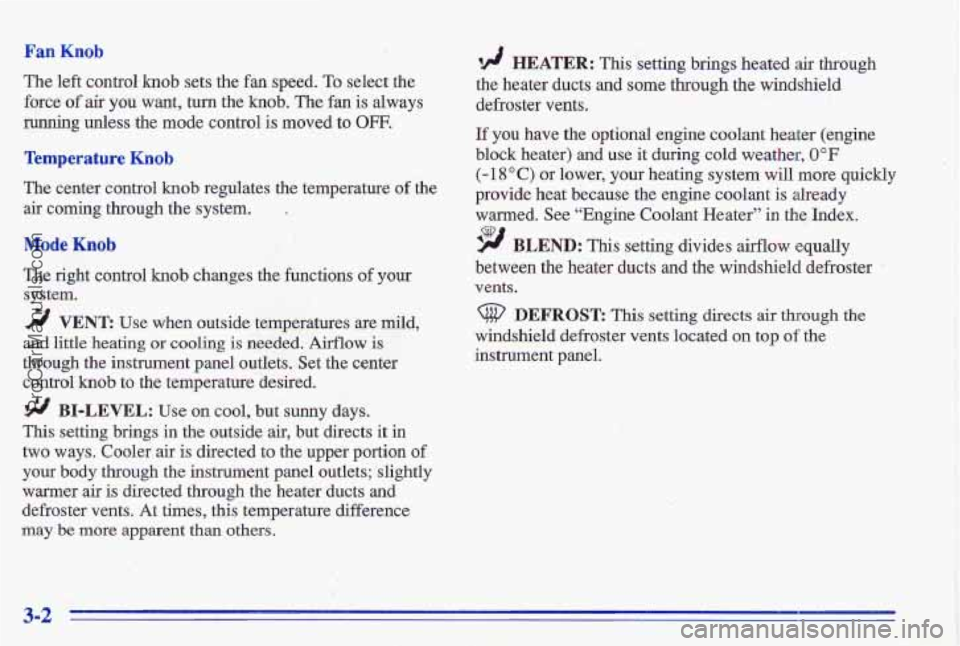
Fan Knob
‘The left controlknob sets the fin speed. To select thle
force
of air you want, turn the knob. The fan is always
runhing unless the mode control is moved to OFF.
Temperature Knob
The center control knob regulates the temperature of the
air coming through the system. ,
Mode Knob
The right control knob changes the functions of your
system.
2 VENT Use when outside temperatures are mild,
and little heating or cooling is needed, Airflow is
through the instrument panel outlets. Set the center
control
hob to the temperature desired.
9 BI-LEVEL: Use on cool, but sunny days.
This setting
brings in the outside air, but directs it in
two
ways. Cooler air is directed to the upper portion of
your body through the instrument panel outlets; slightly
wanner
air is directed through the heater ducts and
defroster vents. At times, this‘temperature difference
may be more apparent than others,
d HEATER: This setting brings heated air through
the he’ater ducts and some through the windshield
defroster vents.
If you have the optional engine coolant heater (engine
block heater)
and use it during cold weather, 0°F
(- 18 O C) or lower, your heating system will more quickly
provide heat be’cause the engine coolant is already
warmed. See “Engine Coolant Heater” in
the Index.
9 BLEND: This setting divides airflow equally
between the heater ducts
and the windshield defroster ’
vents.
DEFROST
This setting directs air though the
windshield gefroster vents located on top of the
instrument panel,
3-2
ProCarManuals.com
Page 125 of 356

Climate Control System with Air Conditioning (Option)
< _.-
1 !
Mode Knob
The right control knob changes the functions of your
system.
MAX: Use for maximum cooling. This setting
recirculates much
of the air inside your vehicle. It
maximizes your air conditioner’s performance and your
vehicle’s fuel economy.
A/C: Use for normal cooling on hot days. This setting
cools outside air and directs it through the instrument
panel outlets.
BI-LEVEL: Use on cool, but sunny days.
This setting brings in the outside air, but directs it in
two ways. Cooler air
is directed to the upper portion of
Fan Knob your body through the instrument panel outlets, but
slightly warmer air is directed through the heater ducts
The left control
knob sets the fan speed. To select the and defroster vents. At times, this temperature
force of air
you want, turn the knob. The fan is always difference may be more apparent than others.
running unless the mode control is moved to
OFF.
Temperature Knob
The center control knob regulates the temperature of the
air coming through the system.
3-3
ProCarManuals.com
Page 126 of 356
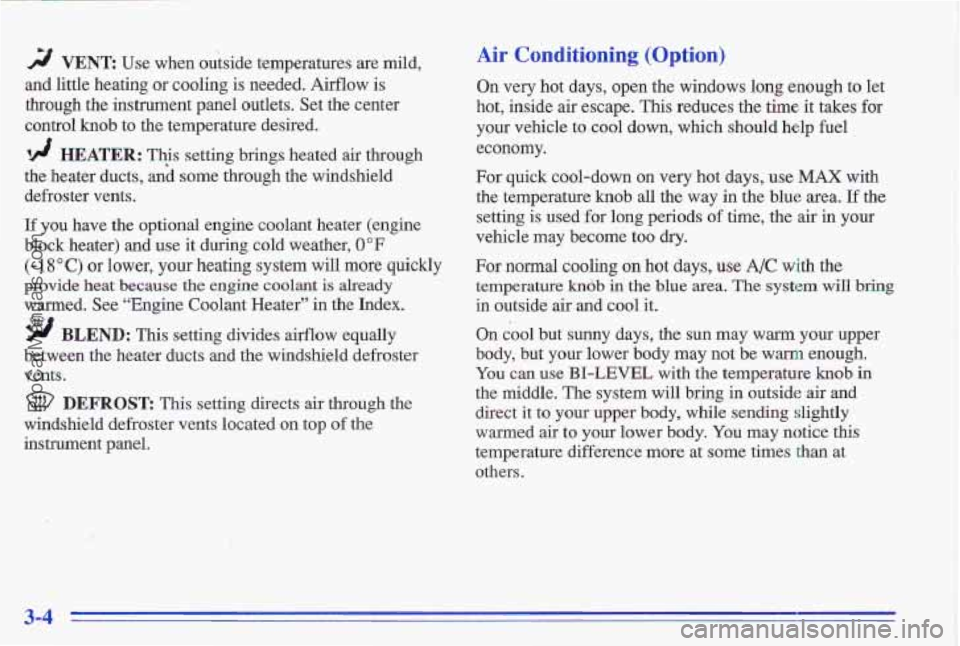
rF/ VENT Use when outside temperatures are mild,
and little heating or cooling is needed. Airflow is
through the instrument panel outlets. Set the center
control
knob to the temperature desired.
‘!! HEATER: This setting brings heated air through
the heater ducts, aid some through the windshield
defroster vents.
If you have the optional engine coolant heater (engine
block heater) and use it during cold weather,
0°F
(- 1 8 O C) or lower, your heating system will more quickly
provide heat because
the engine coolant is already
warmed. See “Engine Coolant Heater”
in the Index.
9 BLEND: This setting divides aeflow equally
between the heater ducts and the windshield defroster
vents.
DEFROST This setting directs air through the
windshield defroster vents located on top of the
instrument panel.
Air Conditioning (Option)
On very hot days, open the windows long enough to let
hot, inside air escape. This reduces the time it takes for
your vehicle to cool down, which should help fuel
economy.
For quick cool-down on very hot days,
use MAX with
the temperature
knob all the way in the blue area. If the
setting is used for long periods
of time, the air in your
vehicle may become too dry.
For normal cooling on hot days, use A/C with the
temperature
kndb in the blue area. The system will bring
in outside air and cool it.
On cool but sunny days, the sun may warm your upper
body, but your lower body may not be warm enough.
You can use BI-LEVEL with the temperature knob in
the middle. The system will bring in outside air and
direct it to your upper body, while sending slightly
warmed air
to your lower body. You may notice this
temperature difference more at some times than at
others.
3-4
ProCarManuals.com
Page 127 of 356

Hc-4ing
‘lix---lg the right control knob to HEATER and the
center control
knob clockwise sends some heated air
through the heater ducts toward your feet and some
through the defroster vents.
Veri, 3ys1
Use when outside temperatures are mild, and little
heating or cooling is needed. Turn the right knob to
VENT. Airflow is directed through the instrument panel
outlets. Set the center knob to the temperature desired.
VENT and HEATER are economical positions because Your Pontiac’s flow-through ventilation system supplies
the air conditioner compressor doesn’t run in these two outs\
ide air into the vehicle when it is moving. Outside
settings. This reduces engine load, resulting in improved
air will also enter the vehicle when the heater or the air
fuel economy.
If either setting fails to keep you conditioning fan is running.
comfortable, or causes your windows to fog up, turn
the right control
knob to one of the air conditioning Adjust the direction of
positions, or to DEFROST. airflow by moving the
If
you have the optional engine coolant heater (engine
block heater) and use it during cold weather, 0 OF ,
(- 18 O C) or lower, your heating system will more
quickly provide heat because the engine coolant is
already
warmed. See “Engine Coolant Heater”
the Index. louvered vents.
3-5
ProCarManuals.com
Page 172 of 356
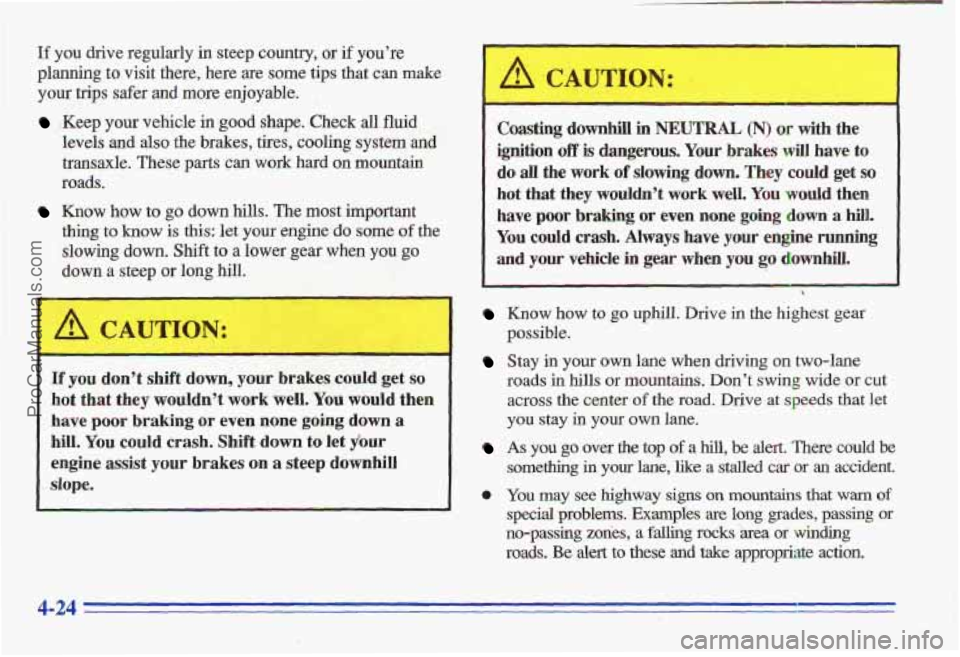
If you drive regularly in steep country, or if you’re
planning t’o visit there, here are some tips that can make
your trips safer and more enjoyable.
!Keep your vehicle in good shape. Check dl fluid
levels
and also the brakes, tires, cooling system and
transaxle.
These parts can work hard on mountain
roads.
Know Bow to go down hills. The most important
thing to know is this: let your engine do some of the
slowing down. Shift to a lower gear when you go
down a steep or long hill.
If you don’t shift down, your brakes could get so
hot that they wouldn’t work well. You would then
have poor braking
or even none going ddwn a
hill. You could crash. Shift down to let jour
engine assist
your brakes on a steep. downhill
.. slope.
Coasting downhill in NEUTRAL (N) or dvith the
ignition
off is dangerous. Your brakes will have to
do all the work of slowing down. They could get so
hot that they wouldn’t work well. You would then
haxe
poor braking or even none going down a hill.
You could crash. Always have your engine running
and your vehicle
in gear when you go downhill.
Know how to go uphill. Drive in the highest gear
possible.
Stay in your own lane when driving on two-lane
roads
in hills or mountains. Don’t swing wide or cut
across the center
of the road. Drive at speeds that let
you stay in your own lane.
As you go over the top of a hill, be alert. There could be
something in your lane, like a stalled car or an accident.
0 You may see highway signs on mountains that warn of
special problems. Examples are long grades, passing or
no-passing
zones, a falling rocks Area or winding
roads. Be alert to these and take appropriate action.
ProCarManuals.com
Page 188 of 356
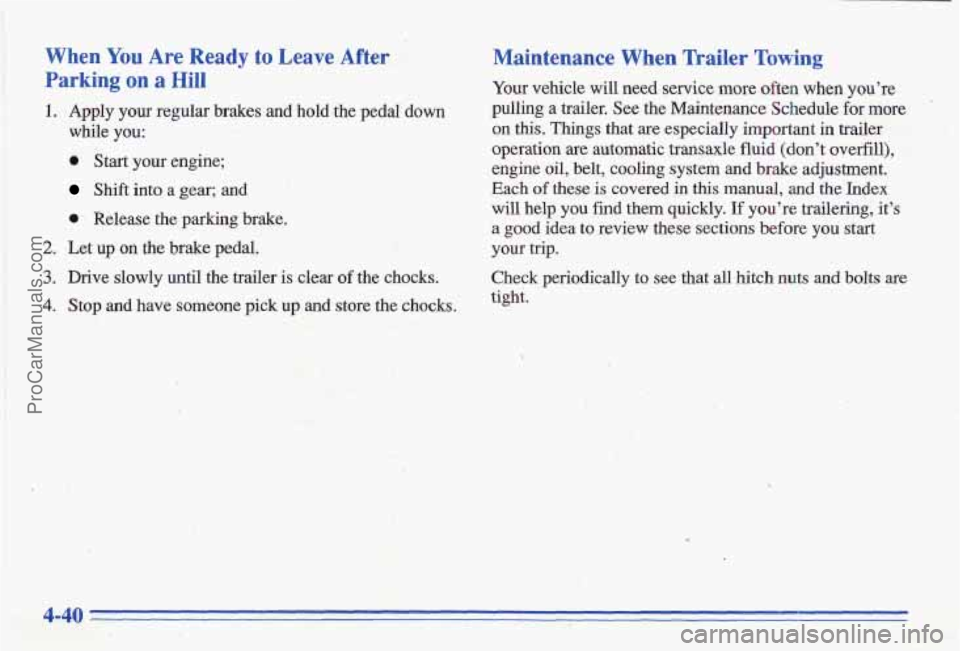
When You Are Ready to Leave After
Parking on a Hill
1. Apply your regular brakes and hold,the pedal down
while
you:
0 Start your engine;
Shift into a gear; and
I. Release the parking brake.
2. Let up on the brake pedal..
3. Drive slowly until the trailer is clear of the chocks.
4. Stop and have someone pick up and store the chocks.
Maintenance When Trailer Towing
Your vehicle will need service more often when you're
pulling a trailer. See the Maintenance Schedule for more
on this. Things that are especially important in trailer
operation are automatic transaxle
fluid (don't ovel-fill),
engine oil, belt, cooling system and brake adjustment.
Each of these is covered in this manual, and the Index
will
help you find them quickly. If you're trailering, it's
a good idea to review these sections before you start
<* ~ I ,,; ;-':'. .a t , ,--: .. ;::l.$.:$ 5
Check periodically to see that all hitch nuts and bolts are
tight.
your trip. ! . .i . :$ ,,- .,,. . . f ~
_I.,
4-40
ProCarManuals.com
Page 205 of 356
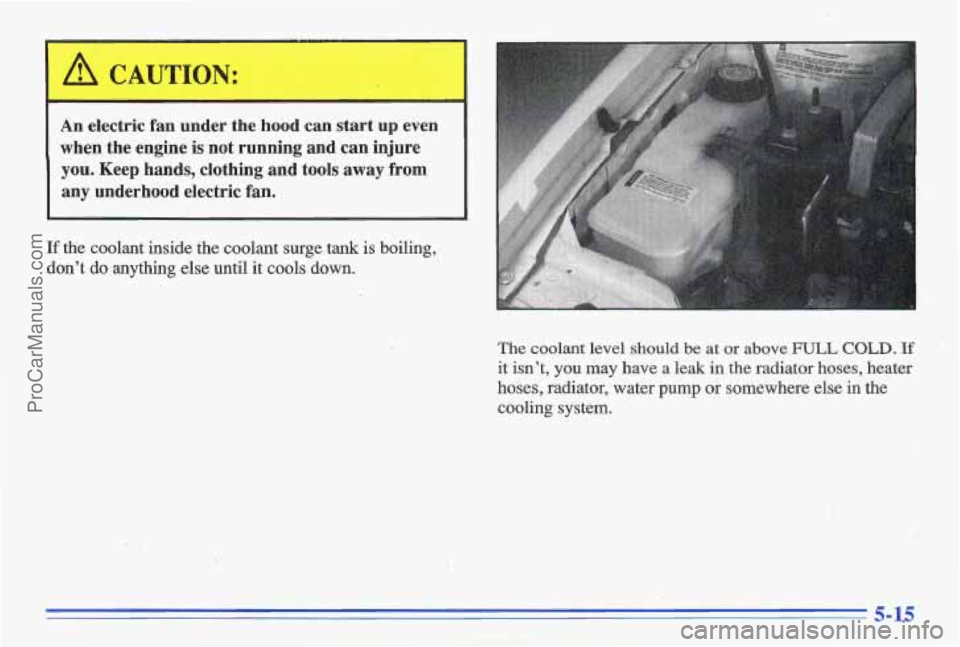
' A CAUTION:
An electric fan under the hood can start up even
when the engine is not running and can injure
you. Keep hands, clothing and tools away from
any underhood electric
fan.
1
If tkie coolant inside the coolant surge tank is boiling,
don't
do anything else until it cools down.
The coolant level should be at or above FULL COLD. If
it isn't, you my have a leak in the radiator hoses, heater
hoses, radiator, water pump
or somewhere else in the
cooling system.
"I '!
_.
-. .
, :.' I' I1
ProCarManuals.com